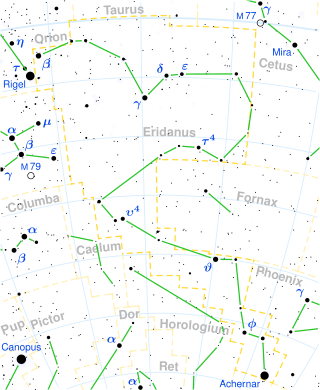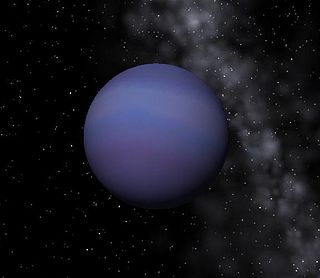
Gliese 876 is a red dwarf star 15.2 light-years away from Earth in the constellation of Aquarius. It is one of the closest known stars to the Sun confirmed to possess a planetary system with more than two planets, after GJ 1061, YZ Ceti, Tau Ceti, and Wolf 1061; as of 2018, four extrasolar planets have been found to orbit the star. The planetary system is also notable for the orbital properties of its planets. It is the only known system of orbital companions to exhibit a near-triple conjunction in the rare phenomenon of Laplace resonance. It is also the first extrasolar system around a normal star with measured coplanarity. While planets b and c are located in the system's habitable zone, they are giant planets believed to be analogous to Jupiter.

HD 10647 is a 6th-magnitude yellow-white dwarf star, 57 light-years away in the constellation of Eridanus. The star is visible to the unaided eye under very dark skies. It is slightly hotter and more luminous than the Sun, and at 1.75 billion years old, it is also younger. An extrasolar planet was discovered orbiting this star in 2003.

Rho Coronae Borealis is a yellow dwarf star 57.1 light-years away in the constellation of Corona Borealis. The star is thought to be similar to the Sun with nearly the same mass, radius, and luminosity. It is orbited by four known exoplanets.
HD 210277 is a single star in the equatorial constellation of Aquarius. It has an apparent visual magnitude of 6.54, which makes it a challenge to view with the naked eye, but it is easily visible in binoculars. The star is located at a distance of 69.5 light years from the Sun based on parallax, but is drifting closer with a radial velocity of −20.9 km/s.
HD 38529 is a binary star approximately 138 light-years away in the constellation of Orion.
HD 1237 is a binary star system approximately 57 light-years away in the constellation of Hydrus.
94 Ceti is a trinary star system approximately 73 light-years away in the constellation Cetus.

16 Cygni Bb or HD 186427 b is an extrasolar planet approximately 69 light-years away in the constellation of Cygnus. The planet was discovered orbiting the Sun-like star 16 Cygni B, one of two solar-mass (M☉) components of the triple star system 16 Cygni in 1996. It orbits its star once every 799 days and was the first eccentric Jupiter and planet in a double star system to be discovered. The planet is abundant in lithium.
Upsilon Andromedae d, formally named Majriti, is a super-Jupiter exoplanet orbiting within the habitable zone of the Sun-like star Upsilon Andromedae A, approximately 44 light-years away from Earth in the constellation of Andromeda. Its discovery made it the first multiplanetary system to be discovered around a main-sequence star, and the first such system known in a multiple star system. The exoplanet was found by using the radial velocity method, where periodic Doppler shifts of spectral lines of the host star suggest an orbiting object.

HD 154345 b is a Jupiter-mass extrasolar planet orbiting the star HD 154345.

109 Piscium b is a long-period extrasolar planet discovered in orbit around 109 Piscium. It is about 5.74 times the mass of Jupiter and is likely to be a gas giant. As is common for long-period planets discovered around other stars, it has an orbital eccentricity greater than that of Jupiter.

Epsilon Eridani b, also known as AEgir [sic], is an exoplanet approximately 10.5 light-years away orbiting the star Epsilon Eridani, in the constellation of Eridanus. The planet was discovered in 2000, and as of 2023 remains the only confirmed planet in its planetary system. It orbits at around 3.5 AU with a period of around 7.6 years, and has a mass around 0.6 times that of Jupiter. As of 2023, both the Extrasolar Planets Encyclopaedia and the NASA Exoplanet Archive list the planet as 'confirmed'.
HD 114762 b is a small red dwarf star, in the HD 114762 system, formerly thought to be a massive gaseous extrasolar planet, approximately 126 light-years (38.6 pc) away in the constellation of Coma Berenices. This optically undetected companion to the late F-type main-sequence star HD 114762 was discovered in 1989 by Latham, et al., and confirmed in an October 1991 paper by Cochran, et al. It was thought to be the first discovered exoplanet
Gliese 86 is a K-type main-sequence star approximately 35 light-years away in the constellation of Eridanus. It has been confirmed that a white dwarf orbits the primary star. In 1998 the European Southern Observatory announced that an extrasolar planet was orbiting the star.
HD 117207 is a star in the southern constellation Centaurus. With an apparent visual magnitude of 7.24, it is too dim to be visible to the naked eye but can be seen with a small telescope. Based upon parallax measurements, it is located at a distance of 105.4 light-years from the Sun. The star is drifting closer with a radial velocity of −17.4 km/s. It has an absolute magnitude of 4.67.

GJ 3021 b, also known as Gliese 3021 b or HD 1237 b, is an extrasolar planet approximately 57 light-years away, orbiting its bright G-dwarf parent star in the Southern constellation of Hydrus. It was discovered with the Swiss Euler Telescope at the Chilean La Silla Observatory in 2000.
HD 117207 b is an exoplanet orbiting at 3.77 astronomical units around HD 117207, taking about 7.14 years to complete its orbit. Its orbit has a low to moderate eccentricity. This planet was announced in January 2005 by Marcy at the Keck Observatory. HD 117207 b has a minimum mass of 1.88 Jupiter masses, and in 2023 its inclination and true mass were determined via astrometry.

Gliese 86 b, sometimes referred to as Gliese 86 A b and/or shortened to Gl 86 b, is an extrasolar planet approximately 35 light-years away in the constellation of Eridanus. The planet was discovered orbiting a K-type main-sequence star by French scientists in November 1998. The planet orbits very close to the star, completing an orbit in 15.78 days.
HD 46375 b is an extrasolar planet located approximately 109 light-years away in the constellation of Monoceros, orbiting the star HD 46375. With 79 Ceti b on March 29, 2000, it was joint first known extrasolar planet less massive than Saturn orbiting a normal star. The planet is a "hot Jupiter", a type of planet that orbits very close to its parent star. In this case the orbital distance is only a tenth that of the planet Mercury. No transit of the planet has been detected, so its inclination must be less than 83°. Because the inclination is unknown, the true mass of the planet is not known.
HD 192263 b, also named Beirut, is a gas giant planet with a mass about three quarters that of Jupiter mass. It orbits the star in a circular orbit completing one revolution in 24 days or so. It was discovered in 2000 by the Geneva Extrasolar Planet Search team. The planet was independently detected by the California and Carnegie Planet Search team.








